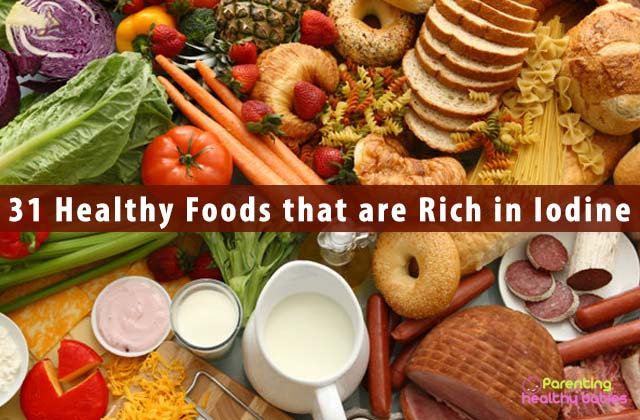Some of the foods with iodine include dried seaweed, cranberries, iodized salt, Himalayan salt, cod, baked potato, milk, shrimp, white rice, bananas, egg, lobster, cheddar cheese, etc. to name a few. There are many vegetables, fruits, legumes, and grains that make it easy to get the iodine your body needs every day. Iodine is found in non-veg foods too
What is Iodine?
Iodine is a component of almost every living animal and plant. It is needed to make the thyroid hormones. These hormones are required for various body processes including growth, regulating metabolism and for the development of a baby’s brain during pregnancy and early life. It is an essential mineral, for instance, the thyroid hormones triiodothyronine and thyroxine contain this mineral. This essential mineral is mainly obtained by maintaining a regular healthy diet. However, it is also a component of some prescription medicines, like – iodophor cleansers, radiology contrast agents and amiodarone. There are numerous foods with iodine that can help you maintain healthy levels of iodine in your body and stay healthy.
31 Healthy Foods that are Rich in Iodine
Fortunately, there are many vegetables, fruits, legumes, and grains that make it easy to get the iodine your body needs every day. Iodine is found in non-veg foods too. Some of the iodine rich foods are given below:
Dried seaweed (1/4 ounce), 4,500 mcg (3000 percent dv)
Seaweed is a good source of antioxidants, vitamins and minerals. It’s also very low in calories and it’s one of the best natural sources of iodine. However, the amount can vary significantly based upon the seaweed type.
Blueberries (4 ounces), 400 mcg (267 percent dv)
Blueberries are rich in antioxidants. These are one of the best fruits for good health. It is estimated that each blueberry contains 113 grams to 400 milligrams of iodine. Consuming them on a regular basis helps functioning of the metabolism to regulate the thyroid activity. It is recommended to consume blueberries in their natural state either in salads or vitamins.
Himalayan crystal salt (1/2 gram), 250 mcg (167 percent dv)
Many people are reducing the maximum consumption of conventional table salt and are trying to absorb a sufficient amount of iodine from other foods. A healthy and complete alternative to replace this food is the himalayan salt crystal, a type of salt that provides 250 milligrams of iodine.
Cod (3 ounces) – 99 mcg (66 percent dv)
Cod is a versatile white fish that’s relatively low in fat and calories and contains a wide range of vitamins and minerals including iodine. According to the icelandic food content database, fish low in fat have the highest iodine amounts. For instance, three ounces or 85 grams of cod has approximately 63 to 99 micrograms or 42 to 66% of the daily recommended amount. The amount of iodine in cod can vary slightly depending on where the fish was. Whether it was farm raised or wild caught, as well as the region where the fish was caught.
Iodized salt (1 gram) – 77 mcg (51 percent dv)
Currently, both iodized and un-iodized salt are sold in the us. The addition of iodine in table salt began in the us in the 1920s to help fight the occurrence of goitres or a swollen thyroid gland. There are approximately 71 micrograms of iodine in a quarter teaspoon of iodized salt, which is 47% of the daily recommended intake. However, salt also contains sodium. Fortunately, the sodium in salt only appears to raise the blood pressure of people who are salt sensitive, which is about 25% of the population. So there’s the option to buy either salt as well.
Navy beans (1 cup), 64 mcg (42 percent dv)
Navy beans may top the list. Just 1/2 cup of these beans contains about 32 mcg of iodine. Beans aren’t just an iodine food they are also incredibly high in fibre.
Baked potatoes (1 medium potato), 60 mcg (40 percent dv)
The potato is one of the most consumed foods in the world and also one of the largest sources of iodine that can be found in the plant kingdom. A potato peeling contains about 60 milligrams of iodine when prepared in the oven.
Soy nuts (1/4 cup), 60 mcg (40 percent dv)
Soy nuts are made from soybeans. They can be soaked in water for a time, then drain and roasted or baked. Soy nuts are full of iodine with about 60 mcg for a quarter cup of soy nuts.
Yogurt
Yogurt is also a good dairy source of iodine. One cup of plain yoghurt provides approximately half of the daily recommended amount.
White bread (2 slices), 45 mcg (30 percent dv)
It is a good choice for people who are suffering from iodine deficiency, as it contains around 45 mcg of iodine in just two slices of bread.
Shrimp (3 ounces) – 35 mcg (23 percent dv)
Shrimp is low calorie, protein rich seafood that is a very good source of iodine. Three ounces contains about 35 micrograms or 23% of the daily recommended intake.
White beans (1 cup), 16 mcg (10 percent dv)
All varieties of beans are very powerful food source that can supplement the diet, however white beans top the list of the best to regulate the functioning of the thyroid, thanks to its iodine content. Half a cup of this type of beans contain up to 8 milligrams of our dining.
Corn (1/2 cup), 14 mcg (9 percent dv)
Corns make up the healthiest snack for all time. Apart from its amazing health benefits, corn is food high in iodine.
Strawberries (1 cup), 13 mcg (9 percent dv)
These red berries are delicious versatile and contain essential nutrients that strengthen the body’s defences. Although they are sweet they are also suitable for improving the health of the thyroid by its important iodine content. One cup of strawberries contains 13 milligrams of iodine, about 10 percent of the dose that each person needs daily. Consume them pure with yogurts, in sweet and vitamins.
Dried prunes (5 prunes), 13 mcg (9 percent dv)
Prunes, which are plums that have been dried out. They’re a good vegetarian or vegan source of iodine. Five dried prunes provides 13 micrograms of iodine or about 9% of the daily value. You might know them better for helping relieve constipation, of course. This is because of their high content of fiber and sorbitol, which is a type of sugar alcohol.
Egg (1 large) – 12 mcg (8 percent dv)
Eggs are also a good source of iodine. On average, one large egg contains 24 micrograms of iodine, or 16% of the daily value. Given that it’s so nutritious and high in protein, you must try to eat them more regularly.
Green peas (1 cup), 6 mcg (4 percent dv)
One cup of green peas provide around 6 mcg of iodine, and that makes it a good option to people who are suffering with iodine deficiency.
White rice (1/2 cup), 4mcg (3 percent dv)
White rice is a suitable food for your diet and it also a food high in iodine.
Bananas (1 medium), 3 mcg (3 percent dv)
Banana is a quick and healthy way to get an energy boost. Thanks to the high potassium content but many people don’t realize that a banana also contain iodine making them a healthy and nutrient-rich food supplement.
Apples (1 medium), 3 mcg (3 percent dv)
Iodine-rich foods also contain this popular fruit which has immense health benefits.
Fortified iodized salt (1 gram), 77 micrograms of iodine (51% dv), 0 calories
It is accepted that 30 ppm (30 mg of potassium iodate per kilogram of salt) is the lowest level that will ensure the provision of 100 mcg of iodine per day.
Baked turkey breast (3 ounces), 34 micrograms of iodine (23% dv), 78 calories
One of the meats that can enter the list of foods high in iodine content is baked turkey breast. It can provide up to 34 mcg of this mineral or 23 % of daily value with 78 calories for 3 ounces of baked turkey breast.
Fish sticks (2 fish sticks), 35 micrograms of iodine (23% dv), 140 calories
Fish sticks also called fish fingers are a type of processed food from some whitefish like pollock, haddock, or cod. With its high iodine content, fish sticks can be a great source of iodine for your body to avoid the iodine deficiency.
Canned tuna (3 ounces), 17 micrograms of iodine (11% dv), 99 calories
Tuna canned in oil is known to have more iodine. For each 3-ounces canned tuna, you can get 17 mcg of iodine or 11 % of your daily recommended value with 99 calories.
Lobster (100 grams), 100 micrograms of iodine (67% dv), 98 calories
One of the seafood with high iodine contents is lobster. For each 100-gram serving size, you can get about 100 mcg of iodine or 67 % daily value and 98 calories.
Cottage cheese (1 ounce), 65 micrograms of iodine (8% dv), 452 calories
Cottage cheese is one of the best cheese sources of iodine. One cup provides 65 micrograms, while one ounce of cheddar provides about 12 micrograms.
Pod
Pod is a kind of healthy vegetable that can be incorporated into any type of diet. Its regular consumption provides the body small amounts of iodine which can serve to stimulate the functioning of the thyroid. Half a cup of beans contains three milligrams of iodine, about two percent of the recommended daily value.
Watercress
It is one of the oldest known leafy vegetables consumed by human beings. Apart from providing many vitamins and healthy nutrients, it also has iodine. It is the best known iodine source for vegans.
Artichoke
Artichokes have amazing health benefits like they are good for bone, boost brain health, help with hypertension, and are also a great source of iodine.
Green vegetables like broccoli and spinach are excellent foods with iodine
Green vegetables come under the category of food high in iodine and are prominent option for vegetarians.
Dairy
Dairy products are a major source of iodine, particularly in American adults. A comprehensive study measured the iodine content in 18 different brands of milk sold in the Boston area. It found that all 18 brands had at least 80 micrograms in one cup, or eight ounces of milk and some brands even contained up to 160 micrograms in one cup. So based on these results, a cup of milk can provide 59 to 112% of the recommended daily amount of iodine.
Amazing Benefits of Iodine in Your Body
Some of the amazing benefits of iodine-rich foods include maintaining higher energy levels in the child’s body, strengthening immunity, boosting metabolism, preventing hypothyroidism, removing toxins, curing goitre, makes for apoptosis and also reduces cancerous growth in the body.
Iodine has numerous benefits for the human body. It prevents cancer. While this essential mineral can help destroy mutated cancer cells, it doesn’t destroy the good cells in the process. For example, women in Japan (who have a very high intake of this mineral because of all the seaweed in their regular diet) have lower rates of breast cancer than women in the United States.
Note – The iodine content in foods can vary considerably. The mineral content of foods depends on the mineral content of the soil where the food was grown. In addition, food grown near the ocean tends to be higher in iodine. The above list of foods with iodine is very comprehensive and should be part of your next grocery list.













